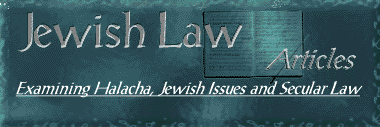

Suing Your Rabbi: Clergy Malpractice in Jewish Law
Rabbi Mark Dratch
Cause for a claim might exist, however, as an actionable tort, if there is a clear and direct relationship between the professional advisor's counsel and the resultant damage.
As a rule, one is liable for the direct and negligent damage he
causes to another's person or
property19
and exempt from indirect,
secondary damages (gerama).20
Thus, in order for a person to be
liable for injuries he caused, his action must be not only the cause
in fact - meeting the sine qua non or "but for" test (i.e., but for
the fact that the defendant so conducted himself the injuries would
not have resulted) - but his action must also be the proximate (i.e.,
foreseeable and direct) cause of the tort. Unless proximate cause is
proved, the tort is considered
A third class of torts, conceptually situated between the liable
direct damage and the exempt indirect cause (gerama) categories is
that of garmi. Examples of garmi damage include: burning
another's bond, thus preventing him from collecting a debt; a
money appraiser's making an erroneous evaluation of coins, causing
financial loss to his client; and informing bandits of another's
property, causing it to be stolen. Major essays elucidating the
nature of garmi have been composed by such rabbinic giants as
Raimban (R. Moses b. Nachman, 1194-1270)21
and R. Shabbetai Cohen (1621-1663) known popularly as Shach, the
accronym of his major work Siftei Cohen.22
Nevertheless, as Shalom Albeck has
correctly observed, a precise explication of the differences between
the exempt gerama and liable garmi torts has eluded talmudic
commentators.23
Some authorities maintain that the result of a
garmi act has greater immediacy than that of
gerama24, or that it has
greater proximity to the cause,25
or greater foreseeablity.26
Others, despairing of finding a cohesive and consistent conceptual
framework for the two notions, hold that there is, indeed, no
difference between them and that certain actions are held liable as
garmi because of their frequency and a government's need to
protect the general welfare of society.27
Views differ as to the nature of the liability of garmi as well.
Some opine that one who commits such an act is not liable for
damages, while others declare him
responsible.28
Even those who
hold him liable - and that is the accepted halacha - differ as to
whether such obligation is biblically prescribed as compensation for
damages caused,29
or whether it is merely a statutory rabbinically
enacted punitive amercement.30
With the preceding as a general introduction to the laws of
damages, let us proceed to the talmudic case of the money
appraiser, Bava Kamma 99b-lOOa, that will serve as the focus of
our discussion of clergy counseling malpractice:
if one person [first]supplies the fire and another the
wood, he who supplies the wood is liable. But where
another person came along and fanned the flame the
one who fanned the flame is liable. If it was the wind
that fanned it, all are exempt.
It was stated: If a dinar was shown to a money
appraiser [and he recommended it as good] but it was
subsequently found to be bad, in one Baraita it was
taught that if he was an expert he is exempt but if an
amateur he is liable, whereas in another Baraita it was
taught that whether he was an expert or an amateur
he is liable. R. Papa stated: The ruling that in the case
of an expert he would be exempt refers to such as
Dankho and Issur who needed no [further]
instruction whatever, but who made a mistake
regarding a new mintage at the time when the coin
had just [for the first time] come from the mint.
Resh Lakish showed a dinar to R. Eleazar who told
him it was good. He said to him, "Chazi de'alach ka
samchina, Behold, I rely upon you." He replied,
"Suppose you do rely upon me, what of it? Do you
think that if it was found bad that I would have to
exchange it [for a good one]? Did not you yourself
state that it was R. Meir [alone] who adjudicates
garmi?" ...But he said to him, "No, R. Meir
maintained so and we do hold with him."
1 | 2 | 3 | Notes

DISCLAIMER
|
|
Page 2 of 3 |
|